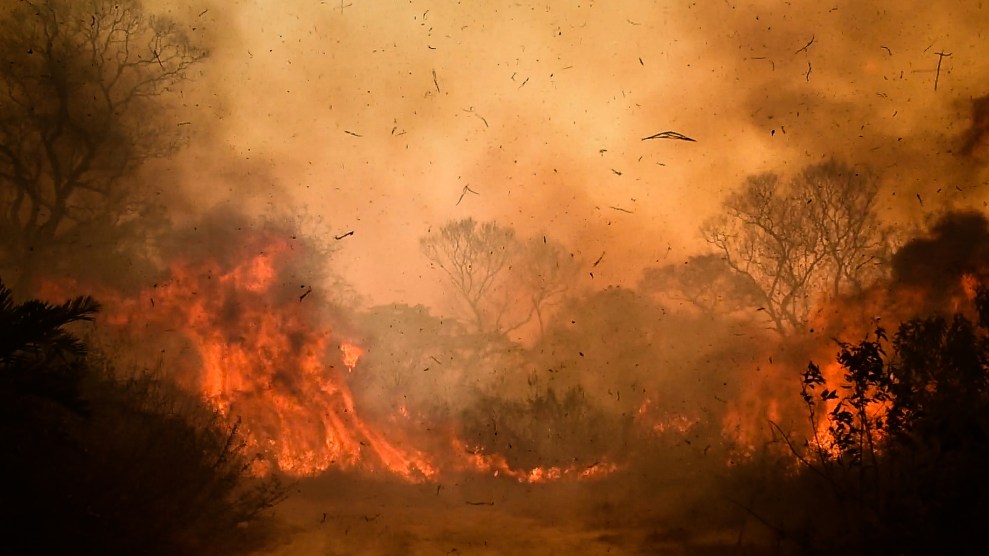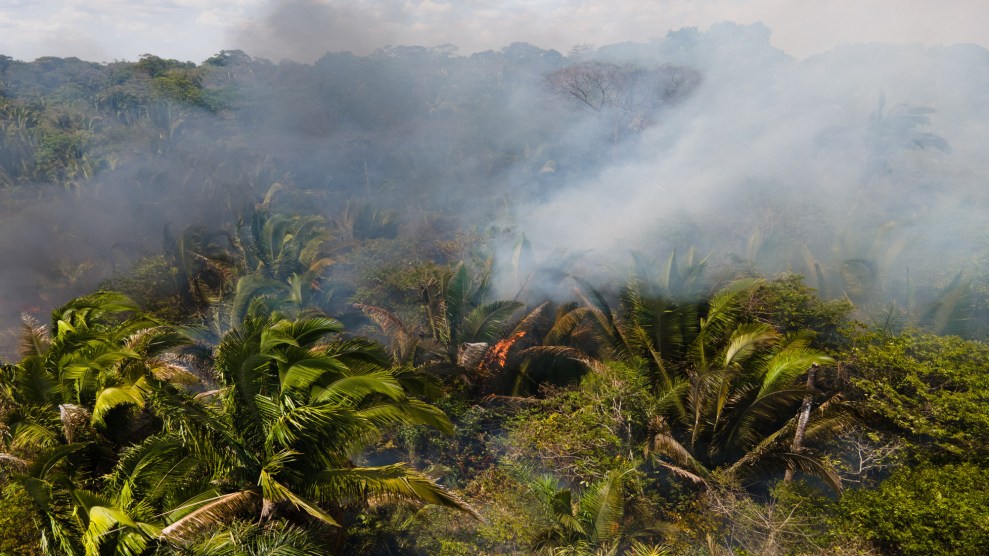
An August 2020 fire in the Brazilian state of Mato Grosso.Gustavo Basso/NurPhoto/Zuma
This story was originally published by Wired and is reproduced here as part of the Climate Desk collaboration.
The Amazon Rainforest is on fire. Or much of it, at least. On February 28, Brazil’s National Institute for Space Research announced that 2,940 fires had burned in the Brazilian Amazon over the course of that month—a record-breaking number for a February. Many of them are still blazing.
Real-time satellite monitoring shows that so far in 2024, more than 10,000 wildfires have ripped across 11,000 square kilometers of the Amazon, across multiple countries. Never have this many fires burned so much of the forest this early in the year. Scientists worry this is pushing the region closer and closer to a tipping point, where widespread degradation and repeated burning of the forest will become unstoppable.
“Fire is a contagious process,” says Bernando Flores, a researcher at Brazil’s Federal University of Santa Catarina, who studies changes in the Amazon. “If nothing is done to prevent fire from penetrating remote areas of the Amazon, the system may eventually collapse from megafires and become trapped in a persistently flammable, open-vegetation state.”
The Amazon Rainforest spans 6.7 million square kilometers, accounting for more than half the planet’s remaining rainforest. It is home to 10 percent of the planet’s terrestrial biodiversity, and plays a vital role in stabilizing both local and global climates. The Amazon stores between 15 and 20 years’ worth of global CO2 emissions, and it has a cooling effect on the world thanks to the moisture that its plants store and transpire into the atmosphere.
Since the 1980s, the Amazon Basin has been warming at an average of 0.27 degrees Celsius per decade. Some parts, including the forest’s central and southeast regions, have been warming even faster, at a rate of 0.6 degrees per decade. Today, dry season temperatures are, on average, 2 degrees higher than they were 40 years ago.
These trends have come to a head this year. A study published in late January by researchers from World Weather Attribution, a scientific collaboration that tracks the influence of climate change on weather, found that the drought that has afflicted the Amazon Basin since the middle of last year is primarily being driven by climate change. This historic drought, the most severe ever recorded in the Amazon, has also been amplified by the El Niño weather phenomenon—a cyclical climate pattern defined by unusually warm temperatures over the central and eastern Pacific Ocean, which typically lasts for 9 to 12 months.
”When we have El Niño, or drought, the forest is drier and more susceptible to wildfire,” says Dolors Armenteras Pascual, an ecologist and professor at the National University of Colombia. Record-high temperatures and this extreme drought have sapped the Amazon’s trees of their moisture, leaving the forest understory littered with woody debris that has grown dry, primed to ignite. Amid this heat and dry air, the trees of the Amazon also struggle to draw the water they need from parched soil. They are “degraded” as a result.
A recent paper published by Flores and colleagues in the journal Nature finds that patterns of rainfall have also changed. In the southern Bolivian Amazon, for example, annual rainfall has declined 20 millimeters per year since the 1980s. The Amazon has become “more flammable” as a result, Flores says.
“Degradation means that you still have standing forest, but you are losing some of the structure, some of the functioning,” says Armenteras Pascual. “You might even look and think it’s really a beautiful forest, but it’s not so healthy.”
Being degraded also makes a forest more prone to wildfire. And once a part of the Amazon burns, it’s more likely to catch fire again. “When a forest burns, trees die, releasing organic matter above the soil and opening the canopy,” says Flores. “Hence, more fuel is available and more sunlight and wind can desiccate this fuel, causing the ecosystem to become more flammable. The consequence is that burnt forests are much more likely to burn again.”
When considering the impacts of human disturbance and extreme drought over recent decades, as much as 38 percent of what remains of the Amazon Rainforest may already be degraded, Flores and his colleagues found.
By considering all of the factors contributing to the degradation of the Amazon—climate change, drought, deforestation, wildfires—the team also developed models projecting heat, degradation, and fire trends into the future. The findings are gloomy. By 2050, their models show, temperatures over the Amazon Basin are expected to be 2 to 4 degrees Celsius warmer than they are today, depending on greenhouse gas emissions over the next two and a half decades. By 2050, the Amazon’s dry season may be a month longer than it is now. Wildfires are expected to increase in frequency and severity.
As a result, they estimate nearly half the Amazon may reach a “tipping point” by 2050, when it will cease being a forest at all and transition into savannah and grassland.
The impacts of this would be devastating on local and global levels. A 2021 report from the Science Panel for the Amazon found that 10,000 of the rainforest’s plant and animal species are at risk of extinction due to climate change and habitat destruction. A widespread collapse like this may well push these species over the edge. Many of the Amazon’s 40 million human inhabitants may be displaced by unbearable heat, and Indigenous peoples in particular would lose their livelihoods, ways of life, and knowledge systems.
As alarmist as this might sound, Armenteras Pascual thinks the warnings of Flores and his colleagues are, if anything, understated. “It’s not like half of the Amazon will collapse and the other half will go on just fine,” she says. “The whole system might collapse—the whole system in terms of hydrology, which is probably the most important role of the Amazon globally, its role in cooling the climate.”
If the Amazon were to undergo a “large-scale collapse” by 2050, as Flores and his colleagues warn, it may emit as much as 120 billion tons of carbon dioxide into the atmosphere, currently equivalent to about 3.5 years of global CO2 emissions. Global temperatures may rise 0.3 degrees Celsius as a result.
For now, the unusually high number of fires are expected to continue burning through the month of April, when the rainy season begins. “It’s fire season,” Armenteras Pascual, who is working with the Colombian government to monitor emissions from fires in the Northern Amazon, says. “Just this past week we had 7,000 hectares burning that no one is talking about, in one of the nature preserves that we have near the border with Venezuela.”
“There are some fires here in Colombia as well,” she adds. Data from the satellites shows that just over 1,000 fires burned in the Colombian Amazon in the first week of March. “Fires are burning,” Armenteras Pascual says, “and they’re picking up.”















